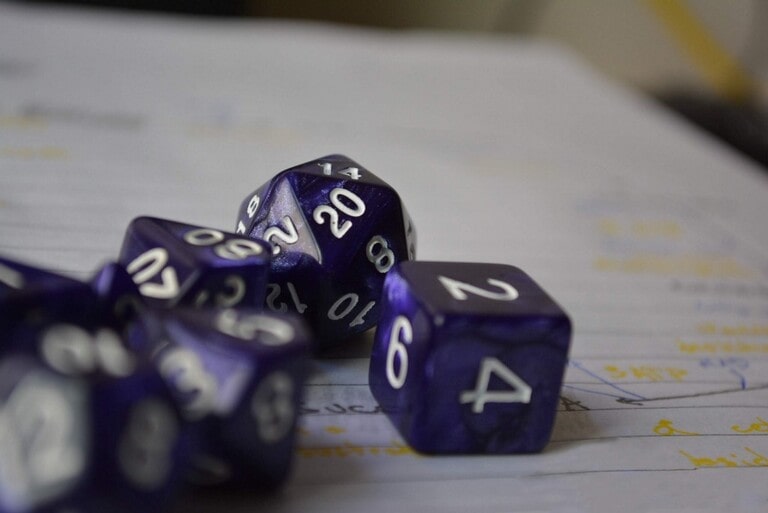How to roll a dice in JavaScript?
By Romain Guillemot- Updated

Let’s build the ultimate dice step by step.
Math.random() as a basis
A dice is a tool providing a random integer each time you roll it. Something like that:
function rollDice() {
return /* some randomly generated number */;
}
Every programming language has a built-in random function. In JavaScript, it’s Math.random:
function rollDice() {
return Math.random();
}
That’s a good start: returning a random number. Remember Math.random is not “random enough” for serious things like cryptography, or casino games – read about Crypto.getRandomValues if that’s your business. Math.random is fair enough to roll a dice with friends. Let’s try it:
>> function rollDice() {
return Math.random();
}
>> rollDice();
<- 0.7367823644188911
This 0.7367823644188911 is not really what we wanted… According to documentation, Math.random returns a decimal number between 0 (inclusive) and 1 (exclusive). For a 6-sided dice, we need an integer from 1 to 6. As a first guess, you may multiply by 6:
>> function rollDice() {
return Math.random() * 6;
}
>> rollDice();
<- 4.3380209914241235
So we would have a random decimal number between 0 (inclusive) and 6 (exclusive). So far, so good. Next step would be to get integer values:
- If 0 ≤
Math.random() * 6< 1, return 1 - If 1 ≤
Math.random() * 6< 2, return 2 - If 2 ≤
Math.random() * 6< 3, return 3 - If 3 ≤
Math.random() * 6< 4, return 4 - If 4 ≤
Math.random() * 6< 5, return 5 - If 5 ≤
Math.random() * 6< 6, return 6
This can be done using Math.floor. Let’s try again – with a for-loop to console.log multiple rolls:
>> function rollDice() {
return Math.floor(Math.random() * 6);
}
>> for(let i = 0; i < 5; i++) console.log(rollDice());
5
1
4
2
0 // WTF?
Once again, not exactly what we wanted… What we get here is:
- If 0 ≤
Math.floor(Math.random() * 6)< 1, return 0. Not 1. - If 1 ≤
Math.floor(Math.random() * 6)< 2, return 1. Not 2. - If 2 ≤
Math.floor(Math.random() * 6)< 3, return 2. Not 3. - If 3 ≤
Math.floor(Math.random() * 6)< 4, return 3. Not 4. - If 4 ≤
Math.floor(Math.random() * 6)< 5, return 4. Not 5. - If 5 ≤
Math.floor(Math.random() * 6)< 6, return 5. Not 6.
To get the wanted result with Math.floor, we will have to add 1 before returning:
function rollDice() {
return 1 + Math.floor(Math.random() * 6);
}
Now we have a function to simulate our 6-sided dice :)
Yes, but… What if we want a 4-, 8-, 12- or 20-sided one?
No big deal: you can change the magic number 6 in the code for a parameter, passing the maximum value for your dice. Something like this:
function rollDice(max) {
return 1 + Math.floor(Math.random() * max);
}
const rollDice4 = () => rollDice(4);
const rollDice6 = () => rollDice(6);
const rollDice8 = () => rollDice(8);
const rollDice12 = () => rollDice(12);
const rollDice20 = () => rollDice(20);
The ultimate dice
I was once inspired by a vision: “The Ultimate Display” by Ivan E. Sutherland, 1965. Among others, I like this quote:
There is no reason why the objects displayed by a computer have to follow the ordinary rules of physical reality with which we are familiar.
We used a parameter to replace the number of sides of our dice. Why not removing the other magic number? This ugly 1 may become an other parameter:
function rollDice(min, max) {
return min + Math.floor(Math.random() * (max - min + 1));
}
const rollDice4 = () => rollDice(1, 4);
const rollDice6 = () => rollDice(1, 6);
const rollDice8 = () => rollDice(1, 8);
const rollDice12 = () => rollDice(1, 12);
const rollDice20 = () => rollDice(1, 20);
const rollSomeUltimateDice = () => rollDice(42, 42);
This final version allows to simulate a dice which is not starting at 1. Moreover the max allows to simulate a uniform fair dice beyond “the ordinary rules of physical reality”. Imagine a 7-sided one. You can mimic your favorite dice game following its ordinary rules. But if you can imagine one, roll a dice which would never exist in reality ;)